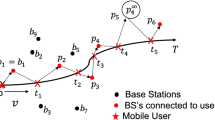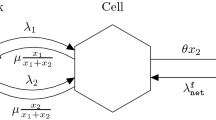Abstract
Methods of balancing call registration and paging are developed in this paper. Given that the probability distribution on the user location as a function of time is either known or can be calculated, previous work shows the existence of lower bounds on the average cost of paging. Here these bounds are used in conjunction with a Poisson incoming-call arrival model to formulate the paging/registration optimization problem in terms oftimeout parameters, τ m ; the maximum amount of time to wait before registering given the last known location wasm. Timer-based methods, as opposed to location-based methods, do not require the user to record and process location information during the time between location updates. This feature might be desirable for minimizing mobile transceiver use during idle periods. We then consider uniform motion processes where a spatial translation of starting location produces an identical spatial translation of the associated time-varying probability distribution. This leads to a universal timeout parameter τ which may be readily calculated. We study τ and the minimum cost of paging/registration for a simple model of user motion and compare our results to an earlier method of location-based paging/registration cost minimization.
Similar content being viewed by others
References
K.S. Meier-Hellsterm, G.P. Pollini and D.J. Goodman, Network protocols for the cellular packet switch, IEEE Trans. Commun. 42(2-4/2) (1994) 1235.
K.S. Meier-Hellstern, E. Alonso and D. O'Neil, The use of SS7 and GSM to support high density personal communications,Proc. Int. Conf. on Communications, ICC'92 (1992).
S. Tabbane, Comparison between the alternative location strategy and the classical location strategy, Winlab-TR 37 (1992).
H. Xie, S. Tabbane and D.J. Goodman, Dynamic location area management and performance analysis,Proc. IEEE Vehicular Technology Conference (1993).
A. Bar-Noy and I. Kessler, Tracking mobile users in wireless networksINFOCOM '93, San Fransisco, CA (1993) pp. 1232–1239.
S. Tabbane, Evaluation of an alternative location strategy for future high density wireless communications systems, Winlab-TR 51 (1993).
G. Pollini and S. Tabbane, The intelligent network signaling and switching cost of an alternative location strategy using memory,Proc. IEEE Vehicular Technology Conference, VTC'93, Seacaucus, NJ (1993).
W. Wang, R.N. Saadawi and K.-i. Aihara, Bandwidth allocation for atm networks,IEEE Int. Conf. on Communications, ICC'90 (1990) pp. 439–442.
S. Okasaka, S. Onoe, S. Yasuda and A. Maebara, A new location updating method for digital cellular systems,Proc. IEEE Vehicular Technology Conference, VTC'91, Denver, CO (1991) pp. 345–350.
A. Awerbuch and D. Peleg, Concurrent online tracking of mobile users,Proc. ACM SIGCOMM Symp. on Communication, Architecture and Protocols (1991).
C. Rose and R. Yates. Minimizing the average cost of paging under delay constraints, Wireless Networks 1 (1995) 211–219.
C.H. Papadimitriou and K. Steiglitz,Combinatorial Optimization: Algorithms Complexity (Prentice Hall, 1982).
W. Feller,An Introduction to Probability Theory and Its Applications, Vol. 1, 3rd Ed. (Wiley, 1968) chap. IV & XIV.
University of Waterloo Symbolic Computation Group, Maple V, Ontario, Canada.
I.S. Gradshteyn and I.M. Ryzhik,Table of Integrals, Series and Products, Corrected and Enlarged Edition (Academic Press, 1980).
Z. Lei and C. Rose, Minimizing paging and registration through time-varying location area boundaries, work in progress.
M. Feder, N. Mehrav and M. Gutman, Universal Prediction of Individual Sequences, IEEE Trans. Inf. Theory 38(4) (1993) 1258–1270.
R.A. Howard,Dynamic Programming and Markov Processes (MIT Press, 1960).
S. Rao and B. Gopinath, Optimizing call management of mobile units, Winlab-TR 63, Rutgers University (1993).
C. Rose, State-based paging/registration: A greedy technique, Winlab-TR 92, Rutgers University, IEEE Trans. Veh. Techn. 12 (1994), submitted.
E.M. Valsbord and V.I. Zhukovski,Introduction of Multi-Player Differential Games and Their Applications (Gordon and Breach, 1988).
R.B. Meyerson,Game Theory: Analysis of Conflict (Harvard Univ. Press, 1991).
W.H. McCrea and F.J.W. Whipple, Random paths in two and three dimensions, Proc. Roy. Soc. Edinburgh 40 (1940) 281–298.
Author information
Authors and Affiliations
Rights and permissions
About this article
Cite this article
Rose, C. Minimizing the average cost of paging and registration: A timer-based method. Wireless Netw 2, 109–116 (1996). https://doi.org/10.1007/BF01225634
Issue Date:
DOI: https://doi.org/10.1007/BF01225634




